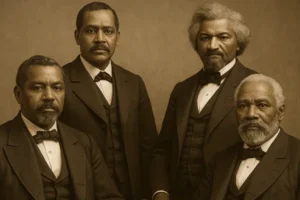Please Don’t Let Them Walk in Your Footsteps
Recently, I saw a meme on LinkedIn that had a picture of two sets of footprints. One set was clearly larger, and the other clearly smaller, intended to represent a father and his son. The caption read, “Be careful where you walk,” to which the child replied, “You be careful—I walk in your footsteps.”
Sounds nice, doesn’t it? Interestingly, the man who posted the meme on his feed added, “Same goes in leadership.” I felt compelled to respond. So, I replied with, “I sure hope not.”

Predictably, not everyone understood my response. Some even wanted to argue. Don’t get me wrong. I understand. Upon first glance, the meme might feel right, but that’s precisely my problem.
Like so many “viral” leadership quotes and memes these days, it is easy to accept because it sounds noble. However, I would argue that it fails under scrutiny. And more importantly, it reflects the kind of thinking that keeps leadership (and its development) in a perpetual state of sentimentality rather than strategic maturity. Moreover, I think it contributes to stagnation and decline (Adversity Nexus).
Sure, sometimes it is important to show someone the ropes, but if outcomes matter at all, then in leadership (and in parenting), we should not want those who follow us to walk in our exact footsteps. We should want them to walk further. We should want them to see further. We should want them to correct our mistakes, not repeat them out of reverence. We should want their steps to be informed by our lessons, not defined by our limitations. Do you see where I’m going with this? I hope so, because the endless supply of short-sighted leadership is destroying minds.
Sure, it might seem trivial to some, but this is where Reasoned Leadership departs from the kind of performative wisdom we see in these memes. A Reasoned Leader asks: What is the consequence of this behavior if scaled? What would happen if every follower simply emulated the leader’s actions without refinement? What innovation would die? What errors would be repeated? And so on, and so forth. Or use Contrastive Inquiry: How much innovation is lost by mimicry? What progress dies in the name of reverence?
I’ll be blunt – if outcomes matter, then so does the point I’m making. Understand that leadership isn’t about walking a path so that others can mimic it. That is simply a terrible idea. Instead, it’s about navigating terrain others wouldn’t have attempted unless you mapped part of it. The goal isn’t (or shouldn’t be) imitation. The goal is (or should be) elevation. If your child, student, or employee ends up doing what you did, exactly how you did it, with no improvement, then you’ve not led, you’ve replicated. That’s not leadership. At best, it might be management, but either way, what progress was truly made?
From a Reasoned Leadership perspective, the metaphor is garbage because it presumes that leadership is primarily about modeling. While behavior is central to the science of leadership, and while modeling is an important component, leadership (done well) is about developing independent reasoning in others. Followers should not simply ask What would my leader do? They should ask, What is the right thing to do based on what I’ve learned from them, and what I’ve added to that knowledge through my own growth?
In my opinion, memes like this don’t just reduce leadership to sentiment, they erode its potential. They suggest that reverence is enough. That legacy is defined by footsteps, rather than vision. Where is the agency in that? Where is the advancement going to come from? And really, wouldn’t such sentiment negate any team-oriented first throughout history?
Of course, I’m not a fan of the footsteps analogy in the first place. After all, footprints are behind us. Leadership is supposed to be vision or future-focused. By function, leaders must look ahead because leadership is about orchestrating a calculated future.
In fact, I’ll say it like this: let the next generation walk beyond us, not in us. Let them see where we’ve stumbled, understand why, and navigate smarter. Granted, this requires a tremendous amount of critical and contrastive thinking, which we should also teach them, but that is how we honor the journey. Not through blind imitation, but through thoughtful iteration.
If you know anything about the actual science of leadership (or want to learn), then you should know it’s much less about the past or retracing someone else’s path. Leadership, in its truest form, is about the future and whether we’ve taught others to build better paths and to walk them boldly, even when others are resistant or unaware they need to exist. This is why quotes that merely sound right can be so dangerous. Sure, they may feel profound, but they often short-circuit growth and stunt potential.
Do we want to be right, or do we want to be accurate? In the actual science of leadership, accuracy demands scrutiny—because sentiment without examination becomes a liability. My advice: Be deliberate about what you follow, and even more deliberate about why you follow it. More importantly, encourage those you lead to make their own path.
The Science Underpinning the Perspective
| Theory / Study | Key Insight |
|---|---|
| Kelley (1992) | Effective followership requires independent, critical thinking and active engagement, not passive emulation. Introduces the two-dimensional mode, emphasizing that exemplary followers think for themselves while remaining actively engaged. |
| Bass & Avolio (1990) | Transformational leadership stimulates intellectual growth and empowers individuals to think and act independently through the “Four I’s” framework, particularly intellectual stimulation. |
| Burns (1978) | Distinguishes transformational leadership—where both leaders and followers elevate each other—from transactional leadership based on role compliance and mimicry. |
| Barling, Weber & Kelloway (1996) | Empirical evidence that transformational leadership training improves both attitudinal and financial outcomes, demonstrating measurable developmental impact on follower independence. |
| Uhl-Bien et al. (2014) | Comprehensive review establishing followership as an active, dynamic process requiring critical thinking and engagement rather than passive compliance with leadership directives. |
| Bass & Avolio (1994) | Organizational effectiveness increases when transformational leadership practices encourage follower self-management, empowerment, and independent decision-making. |
Barling, J., Weber, T., & Kelloway, E. K. (1996). Effects of transformational leadership training on attitudinal and financial outcomes: A field experiment. Journal of Applied Psychology, 81(6), 827–835. https://doi.org/10.1037/0021-9010.81.6.827
Bass, B. M. (1990). From transactional to transformational leadership: Learning to share the vision. Organizational Dynamics, 18(3), 19–31. https://doi.org/10.1016/0090-2616(90)90061-S
Bass, B. M., & Avolio, B. J. (1994). Improving organizational effectiveness through transformational leadership. Thousand Oaks, CA: Sage Publications.
Burns, J. M. (1978). Leadership. New York, NY: Harper & Row.
Kelley, R. E. (1988). In praise of followers. Harvard Business Review, 66(6), 142–148.
Kelley, R. E. (1992). The power of followership: How to create leaders people want to follow, and followers who lead themselves. New York, NY: Doubleday.
Uhl-Bien, M., Riggio, R. E., Lowe, K. B., & Carsten, M. K. (2014). Followership theory: A review and research agenda. The Leadership Quarterly, 25(1), 83–104. https://doi.org/10.1016/j.leaqua.2013.11.007
If you enjoyed this article, you might like these related articles:




